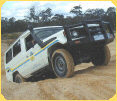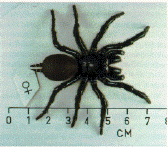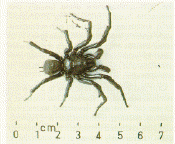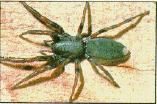 |
 |
|
|
|
||
|
Outback Info (Private Seiten) © seit 1999
Australian Spider and Insect Bites
Of all the thousands of Australian spiders, arthropods and insects, only three have bites which alone are capable of causing death - the funnel-web spider (and related atrax species), the red back spider and the paralysis tick. In most other spider or insect bites, rest and elevation, local application of ice packs and lotions, simple analgesics and antihistamines are all that is required. In some patients, anaphylactic reactions may occur after insect bites, and these may be life threatening. Spider Bites The Sydney funnel web (and a few related atrax species) is unquestionably the most dangerous spider in Australia; the red back and the paralysis tick are the only other two arachnids with potentially fatal bites. Sydney Funnel Web (Atrax robustus)
This is one mother of a spider! It is a large (6-7 cm), black, aggressive, ugly looking spider with massive fangs. These are large and powerful enough to easily penetrate a fingernail. When disturbed it tends to rear up on its hind legs, aggressively exposing the fangs. The spider firmly grips its victim and bites repeatedly; in most cases the experience is horrific. The venom is highly toxic. Before an effective antivenom was developed, significant bites usually resulted in severe symptoms and death was not uncommon. The Sydney funnel web spider is mostly found near Sydney (from Newastle to Nowra and as far west as lithgow but sightings have been reported as far north as Brisbane. Related species are found along the eastern coast of New South Wales. The Australian Museum has some some general info on their web site. The venom of the slightly smaller male spider is five times as toxic as the female. This is unfortunate, as male funnel webs tend to roam about, particularly after heavy rain in summer, and often wind up indoors. The primary toxic component is atraxotoxin, which alone can cause all the symptoms. The venom also contains hyaluronidase and other components (GABA, spermine, indole acetic acid). For some strange reason, human beings (and other primates and monkeys) are particularly sensitive to the venom, whereas toads, cats and rabbits are almost unaffected! Atraxotoxin causes acute massive release of neurotransmitters at autonomic
and neuromuscular junctions with associated uncontrolled autonomic
hyper-reactivity and muscle twitching, followed about 2 hours later by
neurotransmitter depletion and weakness. Symptoms The bite is usually immediately painful, and if substantial envenomation
occurs, symptoms commence usually within a few minutes. They include,
progressively:
After about 2 hours the muscle fasiculations and most symptoms start to
subside, and are replaced with insidious but profound hypotension, primarily
due to severe cardiac failure. First Aid: The pressure immobilisation technique MUST be commenced as soon as possible. Any delay risks the rapid onset of systemic symptoms. There have been no reports of deaths when effective first aid had been instituted. The patient should immediately be evacuated to a medical facility capable of managing the envenomation. Treatment will require giving antivenom, providing artificial ventilation, and invasively monitoring the patient. Bandages MUST NOT be removed prematurely. There is evidence that the venom may inactivated by prolonged localisation. Institute intravenous access, adequate monitoring (iv, SpO2, non-invasive or arterial BP) and obtain antivenom BEFORE removing first aid bandages! An apparently well patient may suddenly deteriorate when they are removed. The moment symptoms or signs of systemic toxicity develop, the antivenom should be administered intravenously. Supportive management, including oxygen, iv atropine, antihypertensives and sedation is usually required even if the antivenom is given. If the antivenom is administered early, the clinical situation is unlikely to get out of control. Management of severe envenomation involves:
The antivenom is a highly purified rabbit IgG immunoglobulin and is highly effective; it should be given as soon as signs of significant envenomation are seen. Prophylactic adrenaline is not required, nor steroids, and there have been no reports of adverse reactions following its use. Occasionally bites from the mouse spider or other atrax species may develop similar symptoms; if these are severe enough it may be useful to try funnel web antivenom. Red Back (Latrodectus mactans hasselti)
Red back venom contains neurotoxins, but works very slowly. Fatalities, even from untreated bites, are rare. The bite is immediately painful; the pain may involve the whole limb. Sweating is common, starting only on the affected limb. Systemic envenomation usually results in headache, nausea, vomiting, abdominal pain, pyrexia, hypertension and in severe cases, paralysis. Untreated, the symptoms worsen over a 24 hour period and may take weeks or months to resolve. The pressure and immobilisation technique is NOT recommended as local pain may become excruciating. It may be relieved by the application of ice packs. The red back specific anti-venom is reliable and is given to around 250 cases each year. It should be withheld unless signs of systemic envenomation develop, and if none occur with 24 hours is usually not required. However, if administration is delayed, it is still effective in relieving symptoms up to 10 days after the bite. Antivenom may be given intramuscularly, because of the small volume involved. Adrenaline need not be given beforehand, unless the patient has prior exposure to equine antivenom or antitoxin or has an allergy to equine protein, in which case steroids should be given for four days as well. White Tail
The precise cause is unknown, however it appears to be due to locally acting necrotising toxin (the recluse venom alone causes necrosis), probably in association with secondary infection. Approximately 25% of cases are associated with skin cultures positive for staphlococci . Strep pyogenes or mycobacterium ulcerans have been causatively implicated, however new evidence suggests that mycobaterium ulcerans may not play a significant role in the syndrome.Treatment depends on severity. Please review the literature. If an area of redness and blistering develop, the limb should be elevated and the patient rested. No drug treatments, including antibiotics, have been clearly shown to be effective at this stage. Blisters may be cultured and a microbiologist needs to be involved to look for mycobacteria as well as other bacteria. Antibiotics should be administered on positive culture or on reasonable suspicion of secondary infection, however poor clinical response is to be expected. Lesions ahould be carefully observed; it may be a good idea to photograph them daily, and the patients temperature and general condition should be observed and recorded. Should the situation deteriorate, the skin may start to look mottled or pale or bluish, or the redness and swelling may spread widely. This is unusual, but if it happens the patient needs admission to hospital. Ruling out serious secondary infection is advisable; this may include skin biopsy. The role of empirical antibiotic therapy is unclear. Should gangrene and/or skin necrosis occur surgical management may be appropriate, however early aggressive surgical therapy is not advocated. Hyperbaric Oxygen and Dapsone have been shown to be of benefit, mostly on data from treatment of experimental brown recluse venomation of animal models. "If you live in Australia, have been bitten recently (in the last few days) by a spider and have the spider that bit you, AVRU would like to hear from you. There has been some difficulty in clearly identifying the offending spider in cases of necrotising arachnidism. Convalescent serum (stored at -20C) may be tested against known spider venom components.
|
Schatzsuche in Down Under / Fossicking
|
||||||||||||||||||||||||||||||||||||||||||||||||||||||||||||||||||||||||||||||||||||||||||||||||||||||||||||||||||||||||||||||||||||||||||||||||||||||||||||||||||||||||||||||||||||||||||||||||||||||||||||||||||||||||||||||||||||||||||||||||||||||||||||||||||||||||||
Australien-Kanal.de © seit 1999, Fossicking.de © seit 1999






 Female
funnelweb on the left, male on the right.
Female
funnelweb on the left, male on the right. The
adult female red back is about 2-3 cm long, quite black, with a distinctive
red stripe on its abdomen. The male is much smaller and considered harmless.
Neither are aggessive. Here's some
The
adult female red back is about 2-3 cm long, quite black, with a distinctive
red stripe on its abdomen. The male is much smaller and considered harmless.
Neither are aggessive. Here's some
 The
white-tailed spider (Lampona cylindrata), and bites from some other spiders,
such as the common black window or house spider (Badumna species), the
cupboard or brown spider, and (in the US)the brown recluse (Loxosceles reclusa)
and hobo spiders (Tegenaria agrestis), have been infrequently implicated in
the development of the so-called necrotising arachnidism syndrome, in which a
near-painless bite progresses to painful cutaneous blistering and inflammation
which may progress into intensely cyanotic lesions, occasionally resulting in
substantial recurrent local tissue necrosis with a deep rolled ulcer involving
fat and skin and exposing muscle. Amputation has been required for severe
necrosis, and ulcer recurrence may last for years.
The
white-tailed spider (Lampona cylindrata), and bites from some other spiders,
such as the common black window or house spider (Badumna species), the
cupboard or brown spider, and (in the US)the brown recluse (Loxosceles reclusa)
and hobo spiders (Tegenaria agrestis), have been infrequently implicated in
the development of the so-called necrotising arachnidism syndrome, in which a
near-painless bite progresses to painful cutaneous blistering and inflammation
which may progress into intensely cyanotic lesions, occasionally resulting in
substantial recurrent local tissue necrosis with a deep rolled ulcer involving
fat and skin and exposing muscle. Amputation has been required for severe
necrosis, and ulcer recurrence may last for years.